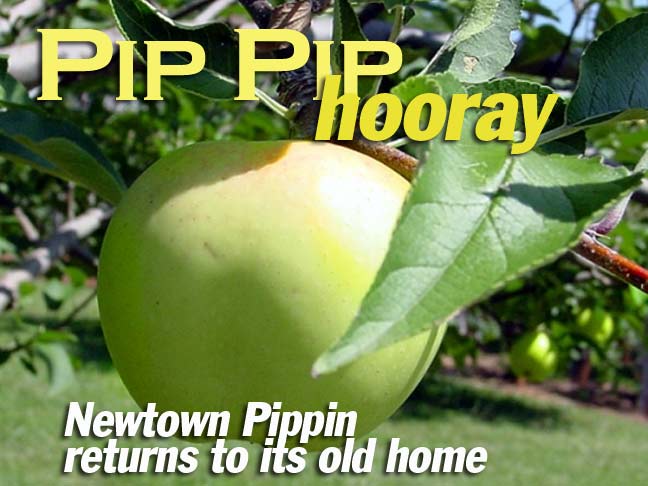The Newtown Historical Society, in conjunction with The Newtown Pippin Project, identified 3 locations at which to plant historic Newtown Pippin apple trees, bringing the fruit back to its place of origin. The fruit trees were planted today at Maspeth Federal Savings, the Middle Village 75th Street Block Association’s community garden and at Ridgewood’sOnderdonk House.
The Newtown Pippin variety of apple was named after the western area of Queens, once known as Newtown Township. The original apple tree was located on the Gershom Moore farm along a tributary of Newtown Creek in the 1700s. From it, cuttings were taken and planted in orchards throughout the world. The apples were cultivated by some of our country’s founding fathers, including George Washington and Thomas Jefferson.
(L to R) David Daraio, Assistant Vice President, Maspeth Federal Savings, Christina Wilkinson, President, Newtown Historical Society & City Council Member Elizabeth Crowley celebrate the planting of the Newtown Pippin tree at Maspeth Federal Savings.
As part of a history and environmental project, the Newtown Pippin Project is offering free Pippin trees for planting throughout the city, with added emphasis on locations in western Queens, where the Pippin once grew and was first discovered by colonial Americans. Thanks to a sponsorship from Green Apple Cleaners, care and guidance from the NYC Department of Parks and Recreation, and pioneering local orchard replenishment by Slow Food NYC, a distributed orchard is being created among the city’s open spaces.
The Newtown Historical Society scouted out locations suitable for the trees and volunteers planted them in Maspeth and Middle Village on Monday, October 5th. (The staff of the Ridgewood Historical Society planted those trees.) The planting consists of a Newtown Pippin tree and a pollinator tree. The Onderdonk House received an Elstar apple tree as a pollinator, which is a Dutch variety. The other two locations received St. Edmund’s Russet trees.
“The Newtown Pippin represents an important part of our agricultural history which is often overlooked,” said Christina Wilkinson, President of the Newtown Historical Society. “We hope by bringing a little bit of it back, we can use it as a teaching tool to help people understand the rural past of this area and the once-pristine condition of Newtown Creek.”
Erik Baard, Outreach Coordinator for the Newtown Pippin Project, said, “Let the abundance of these trees, and those to come, remind us of how lush and fertile the Newtown Creek and the surrounding city once were, and inspire our actions.”
“I commend Christina Wilkinson for her leadership in bringing back Maspeth’s own Newtown Pippin tree,” said Council Member Elizabeth Crowley. “As a member of the Environmental Protection committee, I am working with my colleagues to restore the growth of these beautiful trees through New York City and to declare the Newtown Pippin the official apple of the Big Apple!”
Newtown Historical Society will focus on bringing the trees to area schools, houses of worship and cemeteries.
For more information about the Newtown Pippin Project, please visit www.newtownpippin.org orwww.newtownhistorical.org.




3 comments
if those apples get even a whiff of the newtown creek theyll die on the vine!
Folks you convinced me! I am adding two Newtown Pippin Apple Trees to my home orchard in Palm Bay, Florida USDA Zone 9b. Yes the trees do grow in this area and no they don’t need massive amounts of chill hours. Apart from the fact that I like tart/sweet green apples ( I also own two Granny Smith Apple Trees) I think it is kind of cool that I can grow the same apple Thomas Jefferson and George Washington raved about in my lowly home orchard over 200 years later! Hoorah for history!
Where can I get a few Newtown Pippen Apple trees? I live in Illinois but my ancestors lived in Newtown in the 1670’s. They were Walloons aboard the ship the New Netherland bringing settlers to New Amsterdam and Fort Orange (Albany). I have land in Illinois and farms in Southern Wisconsin. Would they grow there?